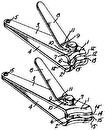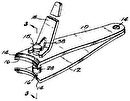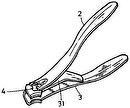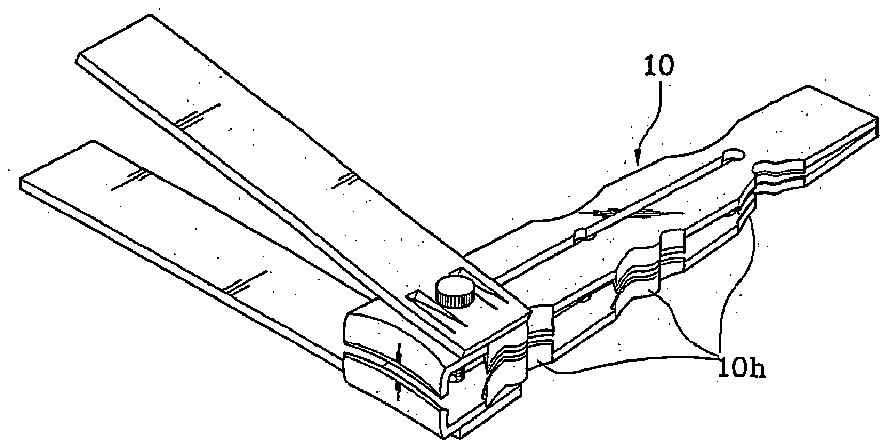
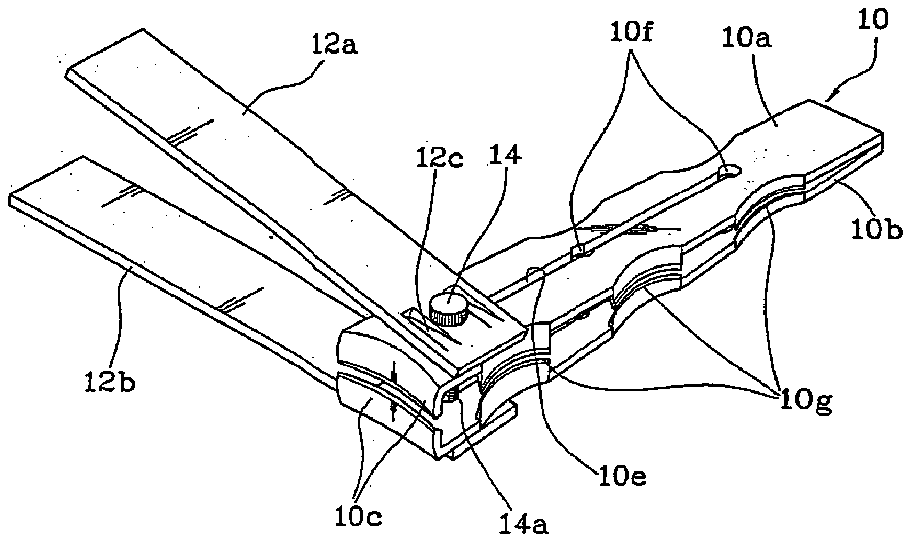
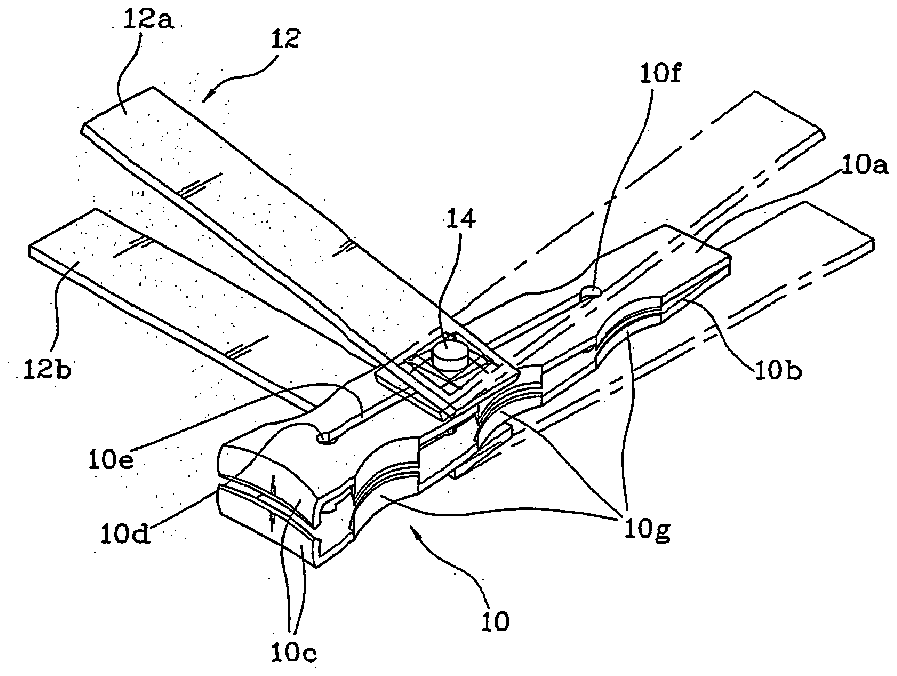
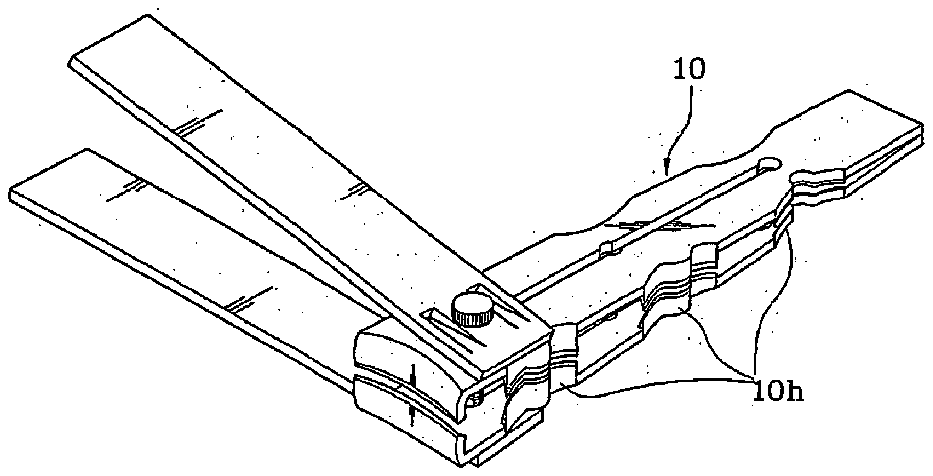
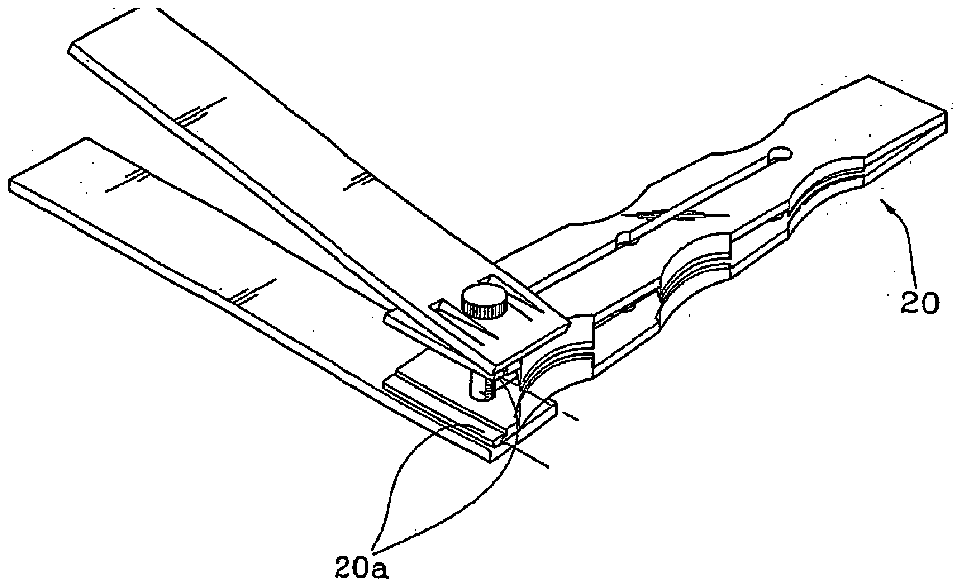
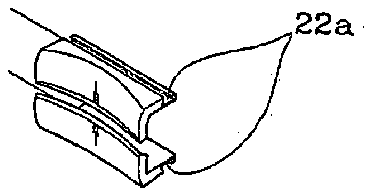
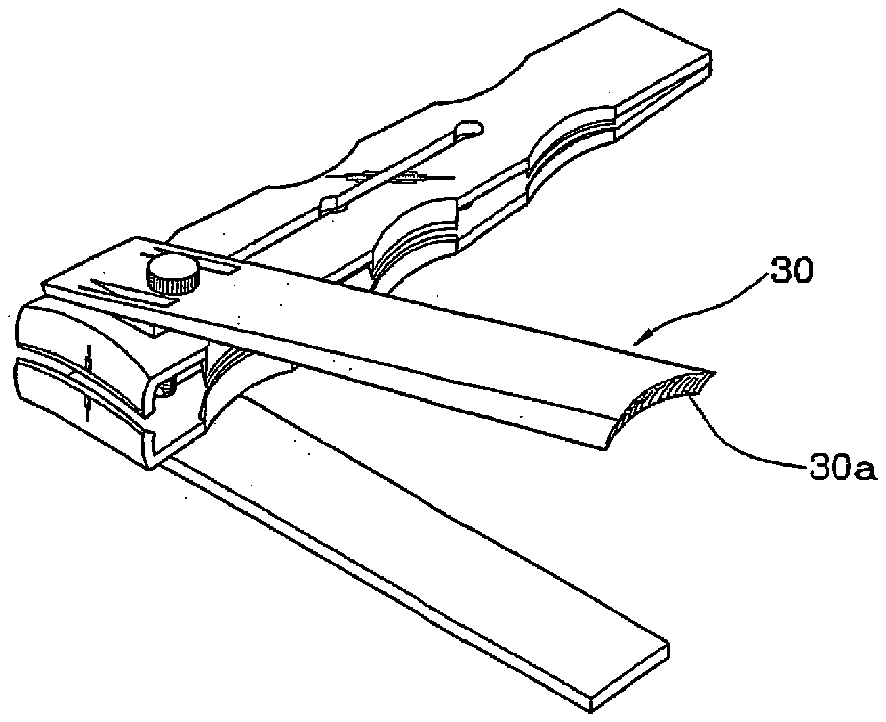
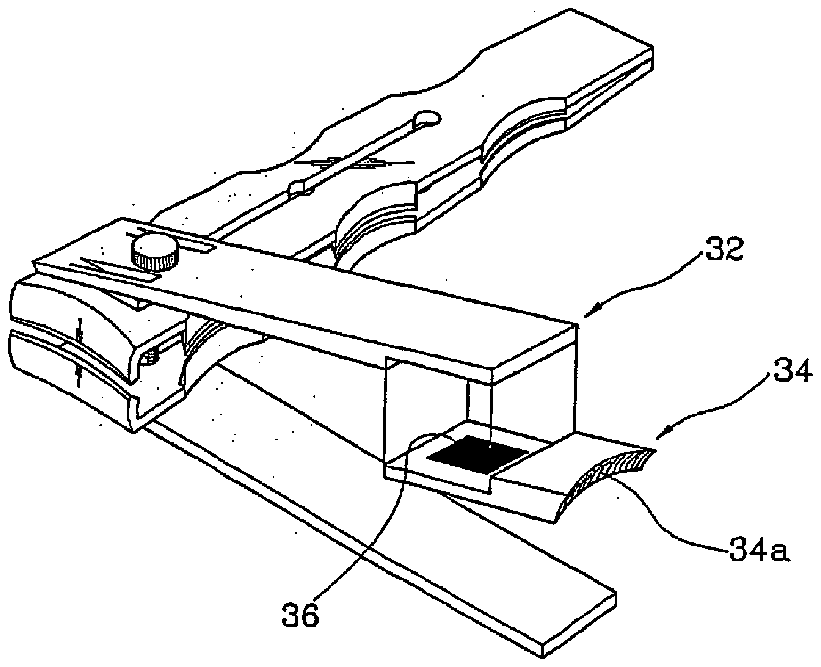
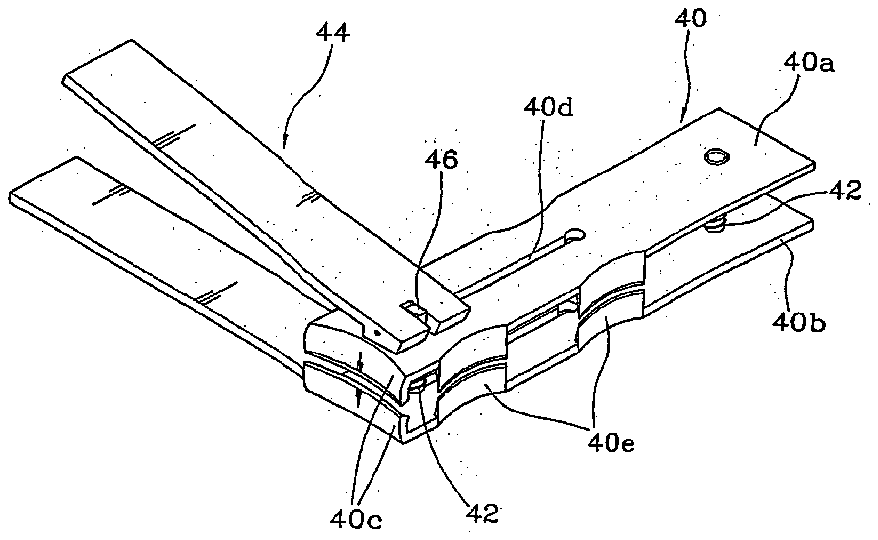
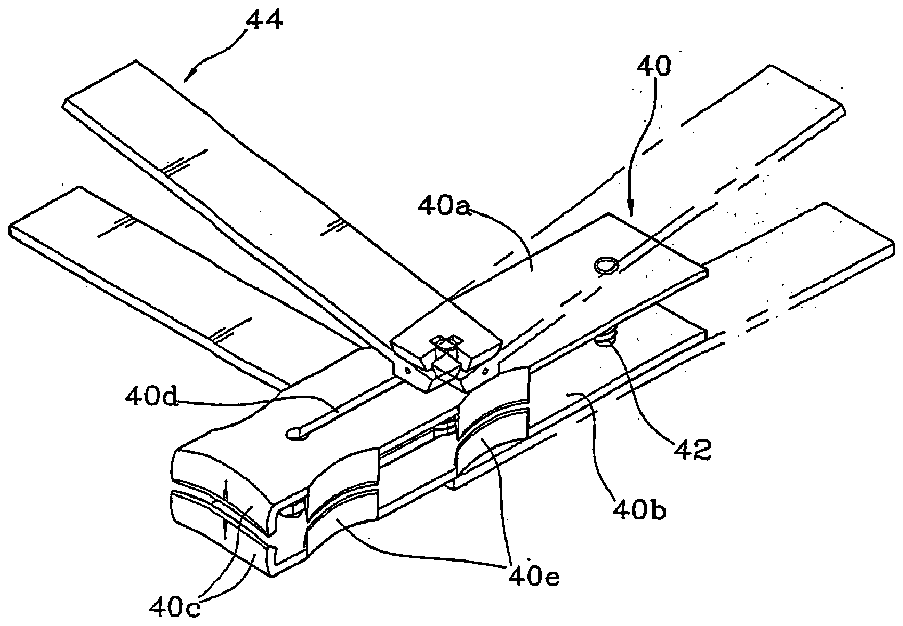
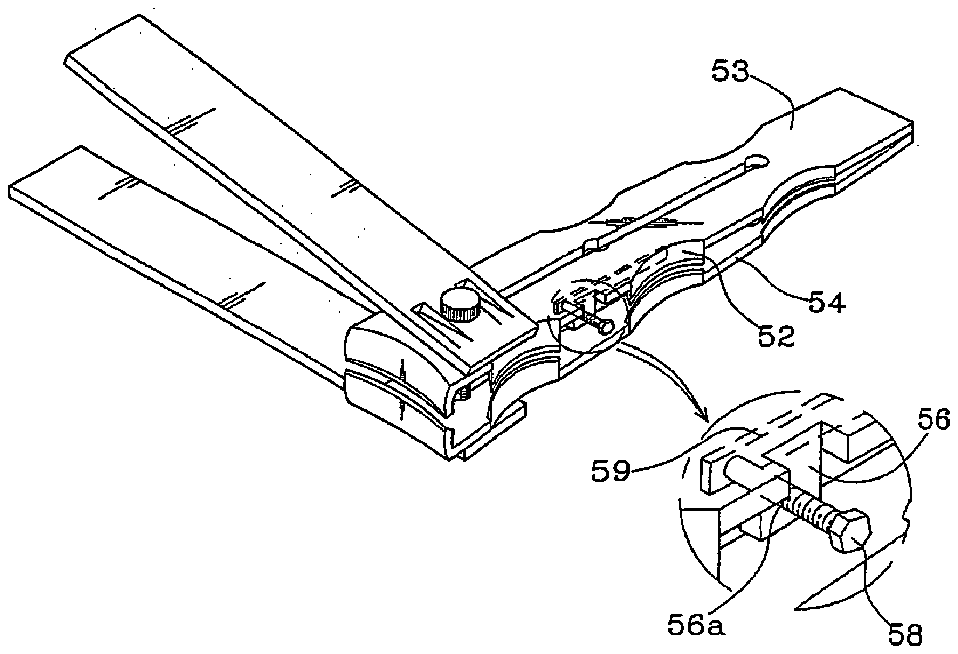
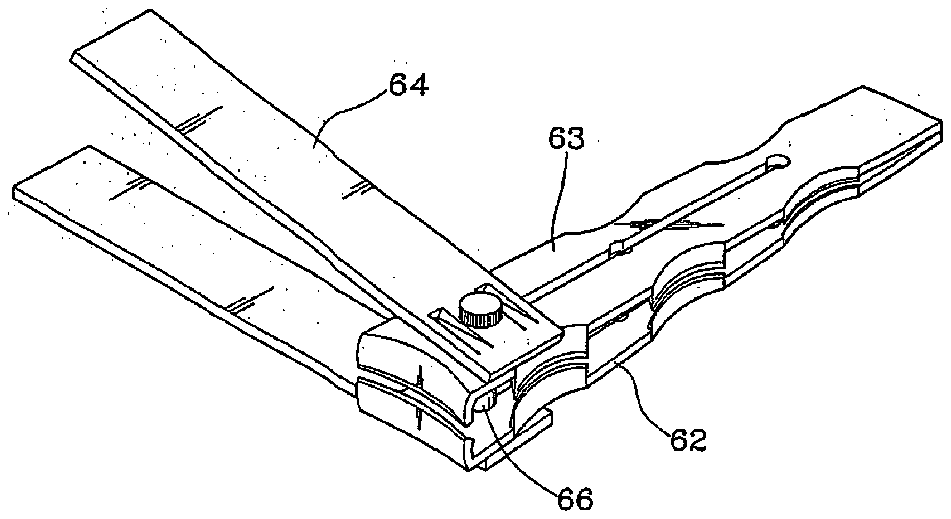
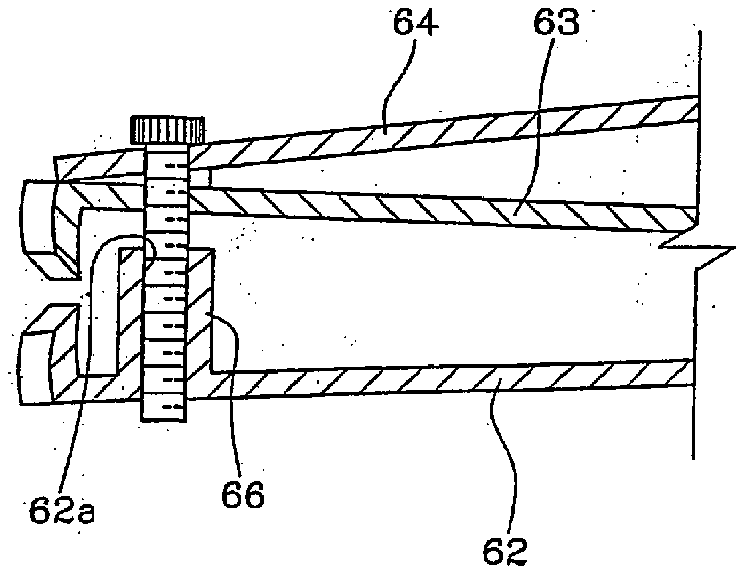
- 10body
- 12lever protrusion
- 14support shaft
- 20body
- 30trimming line
- 40lower steel plates
- 42spring
- 46support shaft
- 50body
- 52cutting edge
- 53lower steel plates
- 56bent portion
- 58coupling member
- 59stop bar
- 60body
- 63upper steel plate
- 200rear
Abstract
The present invention relates to nail clippers, which includes a body ( 10 ) provided with upper and lower steel plates ( 10 a, 10 b ) that have an one end part on which cutting edges ( 10 c ) and through holes ( 10 d ) on the sides adjacent to the cutting edges ( 10 c ) are formed, an operation grip part ( 12 ) that has a pair of pressurizing bars ( 12 a, 12 b ) that have coupling holes that correspond to the thought holes ( 10 d ) and a lever protrusion ( 12 c ) formed on one of the pair of pressurizing bars ( 12 a, 12 b ) corresponding to any one surface of the upper and lower steel plates ( 10 a, 10 b ), and a support shaft ( 14 ) that is passed through the through holes ( 10 d ) of the upper and lower steel plates ( 10 a, 10 b ) and the coupling holes of the operation grip part ( 12 ). The nail clippers according to the present invention are capable of freely rotating the operation grip part ( 12 ) with respect to the body ( 10 ) and further moving the operation grip part ( 12 ) along the surface of the body ( 10 ), thereby allowing a user to clip his or her nails with more ease.
Description
TECHNICAL FIELD
[0001] The present invention relates to nail clippers, and more particularly, to nail clippers that are provided with an operation grip part pressurizing a cutting edge that can be freely rotated with respect to a body and moved along the surface of the body, thereby allowing a user to clip his or her nails with ease.
BACKGROUND ART
[0002] A nail clipper generally includes a body that has upper and lower steel plates connected on one end parts and opened on the other end parts on which are formed a cutting edge, and a pressurizing bar placed on one of the upper and lower steel plates of the body and thus connected with the body by virtue of a support shaft. In operation, if the pressurizing bar is depressed, the support shaft is pulled by the operation of the lever protrusion of the pressurizing bar, which allows the cutting edges to become in contact with each other so that the nail between the cutting edges can be clipped.
[0003] However, since the conventional nail clippers work only in a manner that the pressurizing bar is positioned in a straight line against the body, a user should turn the body along his or her nails rounded in the arc shape at the time of nail-clipping, which of course makes him or her feel that it is inconvenient to use.
DISCLOSURE OF INVENTION
[0004] To solve the above-described problems, it is an object of the present invention to provide nail clippers that are provided with an operation grip part pressurizing a cutting edge that can be freely rotated with respect to a body and moved along the surface of the body, thereby allowing a user to clip his or her nails with ease.
[0005] To accomplish this and other objects of the present invention, there is provided nail clippers that includes: a body provided with upper and lower steel plates that are spaced upward and downward at a predetermined distance, having an one end part on which cutting edges for clipping nails are formed, and forming through holes on the sides adjacent to the cutting edges; an operation grip part that has a pair of pressurizing bars, which are tightly disposed on the outer surfaces of the upper and lower steel plates for pressurizing the upper and lower steel plates to face the cutting edges, provided with coupling holes that correspond to the through holes of the upper and lower steel plates and a lever protrusion that is formed on one of the pair of pressurizing bars to correspond to any one surface of the upper and lower steel plates; and a support shaft that is passed through the through holes of the upper and lower steel plates and the coupling holes of the operation grip part that are in a line, for supporting the operation grip part to be axially rotated with respect to the body.
[0006] According to the present invention, the upper and lower steel plates have one end parts that are in close contact with other such that another end parts on which the cutting edges are formed come elastically in contact with each other, in the state where they are opened, and the support shaft is adopted to be passed through the through holes of the upper and lower steel plates and the coupling holes of the operation grip part and coupled with the coupling hole of the one of the pair of pressurizing bars and forms a screw thread for adjusting the length thereof, on the outer peripheral surface thereof.
[0007] According to the present invention, the upper and lower steel plates are supported in parallel relation to each other, by means of a spring, such that the cutting edges of the one end parts thereof face elastically to each other.
[0008] According to the present invention, each of the upper and lower steel plates forms a guide rail that is extended from the through hole and is passed through the surface thereof, for moving the operation grip part, the guide rail forming a plurality of station holes to stop the operation grip part and rotate it to be perpendicular to the body so that it is compressively operated, on predetermined portions thereof, and the upper and lower steel plates of the body forming cutting edges on the sides corresponding to the plurality of station holes, the cutting edges on the sides facing each other for nail-clipping as the operation grip part is depressed.
[0009] According to the present invention, the outer peripheral surface of the support shaft is cut proper for the width of the guide rail such that when it reaches one of the station holes, along the guide rail, and is then rotated, it is fixedly supported in each of the station holes.
[0010] According to the present invention, the cutting edges formed on the body have different curved shapes such that the shapes of the nails clipped are different from each other.
[0011] According to the present invention, one of the upper and lower steel plates forms a bent portion that is adjacent to the one cutting edge on the sides of the body and bent toward the space portion between the upper and lower steel plates, the bent portion forming a coupling hole through which a coupling member is inserted, the coupling member connected with a stop bar on a front end thereof, for moving forwardly and backwardly in a width direction of the body corresponding to the length of the nail, thereby protecting the nail from coming in the space portion between the upper and lower steel plates.
[0012] According to the present invention, the operation grip part forms on a rear end part thereof trimming lines that cover only the rough surface of the nail clipped to trim it.
[0013] According to the present invention, the rear end part of the operation grip part on which the trimming lines are formed is attachable and detachable to/from the operation grip part.
[0014] According to the present invention, the cutting edges of the body are attachable and detachable to/from the body.
[0015] According to the present invention, the lower steel plate of the body forms a support part that is protruded upwardly on the outer peripheral portion of the through hole thereof, the support part stopping the descending of the upper steel plate when the upper steel plate is descended by the pressurizing of the operation grip part so that the cutting edges of the upper and lower steel plates are in sufficiently close contact with the nail to clip the nail, thereby protecting the cutting edges from being damaged.
BRIEF DESCRIPTION OF THE DRAWINGS
[0016] Further objects and advantages of the invention can be more fully understood from the following detailed description taken in conjunction with the accompanying drawings, in which:
[0017] [0017]FIG. 1 is a perspective view showing a nail clipper according to a first embodiment of the present invention;
[0018] [0018]FIG. 1 a is a perspective view showing the operation example of the nail clipper according to the present invention;
[0019] [0019]FIG. 2 is a perspective view showing a nail clipper according to a second embodiment of the present invention, wherein cutting edges have different shapes;
[0020] [0020]FIG. 3 is a perspective view showing a nail clipper according to a third embodiment of the present invention, wherein cutting edges of the body are separated;
[0021] [0021]FIG. 4 is a perspective view showing a nail clipper according to a fourth embodiment of the present invention, wherein the operation grip part forms trimming lines on the end part thereof;
[0022] [0022]FIG. 4 a is a perspective view showing the nail clipper of FIG. 4, wherein the rear end part of the operation grip part, on which the trimming lines are formed, is separated;
[0023] [0023]FIG. 5 is a perspective view showing a nail clipper according to a fifth embodiment of the present invention, wherein the upper and lower steel plates are supported by a spring;
[0024] [0024]FIG. 6 is a perspective view showing the operation example for the nail clipper of FIG. 5;
[0025] [0025]FIG. 7 is a perspective view showing a nail clipper according to a sixth embodiment of the present invention, wherein the upper and lower steel plates form a stop bar between them;
[0026] [0026]FIG. 8 is a perspective view showing a nail clipper according to a seventh embodiment of the present invention, wherein the lower steel plate forms a support part around the outer peripheral surface of the through hole thereof, and
[0027] [0027]FIG. 8 a is a partly sectional view showing the principal parts of FIG. 8.
BEST MODE FOR CARRYING OUT THE INVENTION
[0028] Now, an explanation of the preferred embodiment of the present invention will be made with reference to accompanying drawings.
[0029] As shown in FIGS. 1 and 1 a , a nail clipper according to the present invention includes a body 10 having upper and lower steel plates 10 a and 10 b , an operation grip part 12 disposed in close contact with the outsides of the upper and lower steel plates 10 a and 10 b , and a support shaft 14 for supporting the operation grip part 12 such that the operation grip part 12 rotates with respect to the body 10 .
[0030] The upper and lower steel plates 10 a and 10 b of the body 10 , which are generally rectangular shaped members, are connected on one end parts and spaced by a predetermined distance on another end parts, each provided with cutting edges 10 c . The end parts provided with the cutting edge 10 c thereon come in contact with each other by the application of an external force and are elastically opened, then. The upper and lower steel plates 10 a and 10 b are provided with a through hole 10 d that is formed in a line with the support shaft 14 on the surfaces of the steel plates corresponding to the sides adjacent to the cutting edges 10 c , such that the support shaft 14 is passed through the through hole 10 d.
[0031] The upper and lower steel plates 10 a and 10 b are also provided with a guide rail 10 e that is passed through the surfaces thereof and extended from the through hole 10 d , for moving the operation grip part 12 connected to the support shaft 14 . The guide rail 10 e forms a plurality of station holes 10 f in which the moving operation grip part 12 stops and rotates to be perpendicular to the body 10 , on predetermined portions thereof, and the upper and lower steel plates 10 a and 10 b of the body 10 form a plurality of cutting edges. 10 g on the sides corresponding to the plurality of station holes 10 f , the cutting edges 10 g facing each other for nail-clipping as the operation grip part 12 is depressed.
[0032] The guide rail 10 e is relatively a small passage enough to guide the outer peripheral surface of the support shaft 14 that is cut on the face thereof to have a generally small diameter, and when the support shaft 14 reaches one of the station holes 10 f , the corresponding station hole 10 f serves to rotate the operation grip part 12 such that the outer peripheral surface of the support shaft 14 having a generally large diameter is located toward the guide rail 10 e , thereby preventing the support shaft 14 from moving.
[0033] The cutting edges 10 c and log on the body 10 have such the shape and strength that they clip a corresponding nail or toenail by the only one operation of the operation grip part 12 .
[0034] As shown in FIG. 2, the cutting edges 10 h on the front end part and the sides of the body 10 are formed in various curved shapes such that the shapes of the nails clipped are different from each other.
[0035] The support shaft 14 is formed passing through the coupling hole (not shown) of the operation grip part 12 and the through hole 10 d of the body 10 so that the operation grip part 12 is axially rotatable with respect to the body 10 . The support shaft 14 is provided with a screw thread 14 a on the outer peripheral surface thereof such that it is passed through a pressurizing bar 12 a of the operation grip part 12 on which a lever protrusion 12 c is formed, and it is coupled with the screw thread 14 a to a pressurizing bar 12 b of the operation grip part 12 on which lever protrusion 12 c is not formed.
[0036] In this case, in order to prevent the gap between the upper and lower steel plates 10 a and 10 b from being substantially narrowed as the support shaft 14 moves to a rear end part of the body 10 along the guide rail 10 e , the support shaft 14 is appropriately fastened and loosed such that the pressurizing bars 12 a and 12 b can be tightly closed on each surface of the upper and lower steel plates 10 a and 10 b.
[0037] The operation grip part 12 has the pair of pressurizing bars 12 a and 12 b that are tightly disposed on the outer surfaces of the upper and lower steel plates 10 a and 10 b , the coupling holes (not shown) that are in a straight line with the through holes 10 d of the upper and lower steel plates 10 a and 10 b on the front end parts thereof, and the lever protrusion 12 c that is formed on one of the pair of pressurizing bars 12 a and 12 b , so as to pull the support shaft 14 upon operation of the operation grip part 12 and to face the cutting edges 10 c of the body 10 each other at the same time.
[0038] The support shaft 14 is directly passed through the coupling hole of the pressurizing bar 12 a on which the lever protrusion 12 c is formed, and the screw thread 14 a of the support shaft 14 is coupled with the coupling hole of the pressurizing bar 12 b on which the lever protrusion 12 c is not formed, which allows the length of the support shaft 14 to be adjusted, while making the pressuring bars 12 a and 12 b of the operation grip part 12 come in contact with the upper and lower steel plates 10 a and 10 b.
[0039] In the state that a cutting edge 22 of a body 20 is separated from the body 20 , as shown in FIG. 3, it can be attachable and detachable to/from the front end part of the body 20 . This is achieved by forming a coupling groove 22 a on the cutting edge 22 and a coupling protrusion 20 a on the body 20 , so that they are attached and detached each other. At that time, the coupling protrusion 20 a is in the shape of a regular triangle and the coupling groove 22 a is in the shape of a reverse triangle, strongly engaged each other to prevent their separation.
[0040] As shown in FIG. 4, a rear end part of the operation grip part 30 forms trimming line 30 a that takes a generally one fourth arc shape to cover only the rough surface of the nail clipped for trimming it.
[0041] In case of trimming the cut face of the nail clipped, as shown in FIG. 4 a , only the rear 200 end part 34 of an operation grip part 32 on which a trimming line 30 a is formed is separated. That is, the rear end part 34 is attachable and detachable to/from the operation grip part 32 , such that the nail trimming is carried out with ease. In this case, the coupling of the rear end part 34 with the operation grip part 32 is achieved by means of a bonding part 36 such as a magnet that is provided on the surfaces corresponding to each other.
[0042] On the other hand, the one end parts of the upper and lower steel plates 10 a and 10 b of the body 10 are connected in a welding manner and the another end parts thereof face each other by the elasticity of the steel plate and are then separated by a predetermined distance. Besides, as shown in FIGS. 5 and 6, upper and lower steel plates 40 a and 40 b of a body 40 are disposed in parallel relation to each other and between the upper and lower steel plates 40 a and 40 b is provided with a spring 42 that enables a cutting edge 40 c to be elastically operated if an operation grip part 44 is depressed. In case of installing the spring 42 , the upper and lower steel plates 40 a and 40 b are in parallel relation to each other such that when a support shaft 46 is moved along a guide rail 40 d for using the cutting edges 40 e on the sides of the body 40 , it does not need to be adjusted in length. In this case, therefore, the support shaft 46 with no screw thread thereon is desirably employed.
[0043] As shown in FIG. 7, an upper steel plate 53 forms a bent portion 56 that is adjacent to the one cutting edge 52 on the sides of the upper and lower steel plates 53 and 54 of a body 50 and located toward the space portion between the upper and lower steel plates 53 and 54 , the bent portion 56 forming a coupling hole 56 a through which a coupling member 58 is inserted, the coupling member 58 connected with a stop bar 59 on a front end thereof, for moving forwardly and backwardly in a width direction of the body 50 corresponding to the length of the nail thereby protecting the nail from coming in the space portion between the upper and lower steel plates 53 and 54 . In this case, the stop bar 59 may be arranged corresponding to each of the cutting edges 52 , or may be formed for only the single cutting edge 52 .
[0044] As shown in FIGS. 8 and 8 a , a lower steel plate 62 of a body 60 forms a support part 66 that is protruded upwardly on the outer peripheral portion of a through hole 62 a thereof, the support part 66 stopping the descending of an upper steel plate 63 when the upper steel plate 63 is descended by the pressurizing of an operation grip part 64 so that the cutting edges are in sufficiently close contact with the nail to clip the nail, thereby protecting the cutting edges from being damaged.
[0045] Under the above-mentioned configurations of the nail clippers according to the preferred embodiments of the present invention, in case of nail-clipping by using the cutting edges 10 c formed on the one end parts of the body 10 , the operation grip part 12 is in parallel relation to the body 10 and as the operation grip part 12 is depressed, the cutting edges 10 c face each other and clip the desired nail. In case of clipping the edge portions of the nail, the operation grip part 12 rotates to an appropriate position with respect to the body 10 , without facing the body 10 itself toward the edge portions of the nail.
[0046] In case of using the cutting edges 10 g formed on the sides of the body 10 , the operation grip part 12 is in parallel relation to the body 10 and then, the support shaft 14 is moved along the guide rail 10 e to a position where the desired cutting edge 10 g is placed. When the support shaft 14 reaches the corresponding station hole 10 f , the operation grip part 12 is rotated and placed in a perpendicular line to the body 10 , and at this state, the clipping is achieved. While the support shaft 14 is moved along the guide rail 10 e , the outer peripheral surface of the support shaft 14 having the relatively small diameter is moved toward the guide rail 10 e , and on the contrary, if it reaches the corresponding station hole 10 f , the outer peripheral surface of the support shaft 14 having the relatively large diameter is moved toward the guide rail 10 e , such that the support shaft 14 is not moved to the side portion of the station hole 10 f.
[0047] As the operation grip part 12 is moved along the guide rail 10 e to a desired position, the cutting edge 10 g corresponding to the desired position serves to clip the desired nail. And, since the cutting edges 22 that are formed on the one end parts of the body 20 are attachable and detachable to/from the body 20 , they can be exchanged into new ones any time, and the trimming line 30 a that is formed on the rear end part of the operation grip part 3 D serves to trim the cut face of the nail clipped in an accurate manner.
INDUSTRIAL APPLICABILITY
[0048] As set forth in the foregoing, nail clippers according to'the present invention that are provided with an operation grip part that can be freely rotated with respect to a body and further moved along the surface of the body, thereby allowing a user to clip his or her nails with more ease.
[0049] While the present invention has been described with reference to a few specific embodiments, the description is illustrative of the invention and is not to be construed as limiting the invention. Various modifications may occur to those skilled in the art without departing from the true spirit and scope of the invention as defined by the appended claims.

